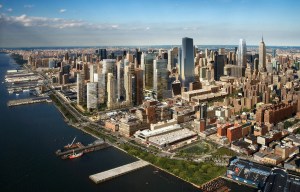A Problem of Design and Demand: We’re Running Out of Room for 15 Penn and Its Big Brothers
By Matt Chaban November 11, 2010 4:38 pm
reprints Add Bloomberg architecture critic James Russell to the list of people none too keen to see Vornado’s 15 Penn Plaza get built (cf. Tony Malkin, hackers). He finds the building undistinguished, but the real problem is its gigantism:
Add Bloomberg architecture critic James Russell to the list of people none too keen to see Vornado’s 15 Penn Plaza get built (cf. Tony Malkin, hackers). He finds the building undistinguished, but the real problem is its gigantism:
A behemoth office tower that may rise opposite Pennsylvania Station would deface New York City’s skyline and cast a pall over surrounding streets already shortchanged on light and air. Vornado Realty Trust’s 15 Penn Plaza will stack as much as 2.83 million square feet on a site that was zoned to accommodate just 1.6 million square feet.
The tower tapers only slightly as it rises about 1,200 feet — the height of the Empire State Building — dwarfing two massive cookie-cutter residential towers to the south that are a sad legacy of Manhattan’s recent housing boom. Architect Rafael Pelli, of Manhattan-based Pelli Clarke Pelli, carved slit-like corner recesses to slim 15 Penn’s glassy bulk, but this overweight monster appears to be bursting at its seams.
He sees more of the same coming, as well, with the redevelopment of Moynihan Station and the million-plus square feet that project is expected to throw off, as well as development further west at Hudson Yards. That project will account for upward of 6 million square feet of commercial development, as well as millions more in slimmer residential towers. There is also Brookfield’s Manhattan West, with two towers of 5.4 million square feet, as well as millions more square feet of amorphous development surrounding the Javits Center.
Things are going to get very crowded on the far West Side.
That is where the problems begin. It is not just all that raw square footage but the out-sized shape it is expected to take and the impact it will have on all those new people.
As Russell suggests and The Journal‘s Anton Troianovski smartly illustrated before him, this is a problem of design and demand. The reason the buildings are so big–so bulky, to use the technical term of art–is that the modern financier requires huge trading floors on which to pack his (it’s almost always a he) bankers, sometimes thousands to a floor, a high-powered, high-frequency sweatshop.
As a result, the step-backed, slender towers that had been the norm at the turn of the last century are obsolete. There is a good reason the Financial District, with its near countless conversions, might as well be called the Residential District nowadays. As for the straight-laced, straight-faced glass modernists of the previous generation, the Seagrams and Nine Wests of New York, those were built up from generous, sometimes windswept, yet still light-filled plazas, a respite from all those flat facades.
But now land is too valuable, tenants too powerful. Every allowable square-foot must be built up, the demands of those inside the building’s trumping those outside. If bigger floorplates are warranted, so be it, even if it means the canyons that are 32nd and 33rd streets grow nearly a thousand feet deeper.
Part of the problem is that this is no longer a fight between midtown and downtown or even between New York, Boston and Chicago, but one between New York and the world. The question is, if Shanghai, Mumbai and Dubai are all O.K. with building–and living–on top of each other, even more so than we famously do here in New York, will we put up with it? Can we?



